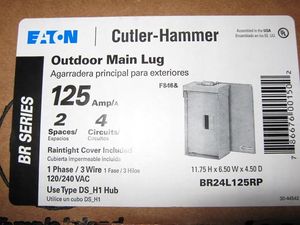CEB Press/Manufacturing Instructions/Case
Jump to navigation
Jump to search
Tools
- Hammer
- Screwdriver with Flathead Bit
- Powered or Manual Metal-cutting Saw
- Cordless Drill with Eighth Inch Twist Drill Bit
- Wire Strippers Compatible with 18 Gauge Wire
- Crimpers Compatible with 16 to 22 Gauge Connectors
Materials
- Outdoor Main Lug Box
- Home Wiring Box
- [2] 8-32 Screws
- 18 Gauge Black Wire
- 18 Gauge Red Wire
- [3] Mounted Wire Clamps
- Fuse Holder
- 10 Amp Bus Fuse
- [2] Female Insulated Connectors for 16 to 22 Gauge Wire
- Splice Connector for 16 to 22 Gauge Wire
- [6] Spade Connectors for 16 to 22 Gauge Wire
- Linked Extension Cord
Steps
- Open the lid of the lug box
- Using the hammer and screwdriver, remove the caps at the bottom-left, bottom-middle, bottom-right, and right-bottom.
- Mount the wire clamps onto the lug box at the bottom-left and right-bottom holes.
- Mount the power switch onto the lug box at the bottom-right hole.
- Using the screwdriver, remove the terminal strip from the lug box.
- Using the metal-cutting saw, cut the terminal strip in half such that two strips are produced, each having 3 terminals.
- Using the screwdriver, mount the 2 terminal strips back onto the lug box.
- Position the home wiring box as a mounting location within the lug box.
- Using the cordless drill and the eighth inch twist drill bit, drill a hole at the plastic flange of the home wiring box and through the metal of the lug box.
- Fasten the home wiring box to the lug box with an 8-32 screw.
- Similarly drill and fasten 3 more points at the home wiring box's plastic flange for secure mounting.
- Using the tin snips, cut 2 pieces of 15cm red wire, 1 piece of 100cm red wire, 1 piece of 15cm black wire, 1 piece of 30cm black wire, and 5 pieces of 100cm black wire. The cutting tolerance is 2cm.
- Using the wire strippers, strip all the ends of all the cut wires by 2cm. The stripping tolerance is half a centimetre.
- Using the crimper, crimp a female connector at one end of the 15cm red wire. Then crimp the splice connector between the other end of the 15cm red wire and one end of the fuse holder wire.
- Using the crimper, crimp a female connector at one end of the 30cm black wire.
- Using the crimper, crimp a spade connector at one end of the 100cm red wire and the 5 pieces of 100cm black wire.
- Insert the non-clip end of the linked extension cord into the bottom-left hole of the lug box.
- Using the screwdriver with the flathead bit, screw the exposed black wire to the lower terminal strip and connect the red wire to the power pin of the power switch. Then screw the wire clamp such that the linked extension cord is tightly mounted inside the lug box.
- Using the screwdriver with the flathead bit, screw the exposed end of the fuse holder wire to the upper terminal strip. Connect the other end of the fuse holder wire to the ACC pin of the power switch.
- Using the screwdriver with the flathead bit, screw the exposed end of the 30cm black wire to the lower terminal strip. Connect the other end of the 30cm black wire to the ground pin of the power switch.
- Using the screwdriver with the flathead bit, screw the 15cm red wire to the upper terminal strip and the 15cm black wire to the lower terminal strip.
- Insert the exposed end of the 100cm red wire into the lug box through the bottom-middle hole.
- Using the screwdriver with the flathead bit, screw the exposed end of the 100cm red wire to the upper terminal strip.
- Insert the exposed ends of the 5 pieces of 100cm black wire into the lug box through the bottom-middle hole.
Steps
- Set up the lug box
- Using a metal cutoff saw, cut in half the terminal strip that is inside the outdoor main lug box in order to create a positive and a negative set of terminal blocks with 3 terminals each.
- Mount the home wiring box to the inside of the outdoor main lug box by

